ECU BMW M3 CONVERTIBLE 2006 E46 Owner's Manual
[x] Cancel search | Manufacturer: BMW, Model Year: 2006, Model line: M3 CONVERTIBLE, Model: BMW M3 CONVERTIBLE 2006 E46Pages: 174, PDF Size: 2.68 MB
Page 3 of 174
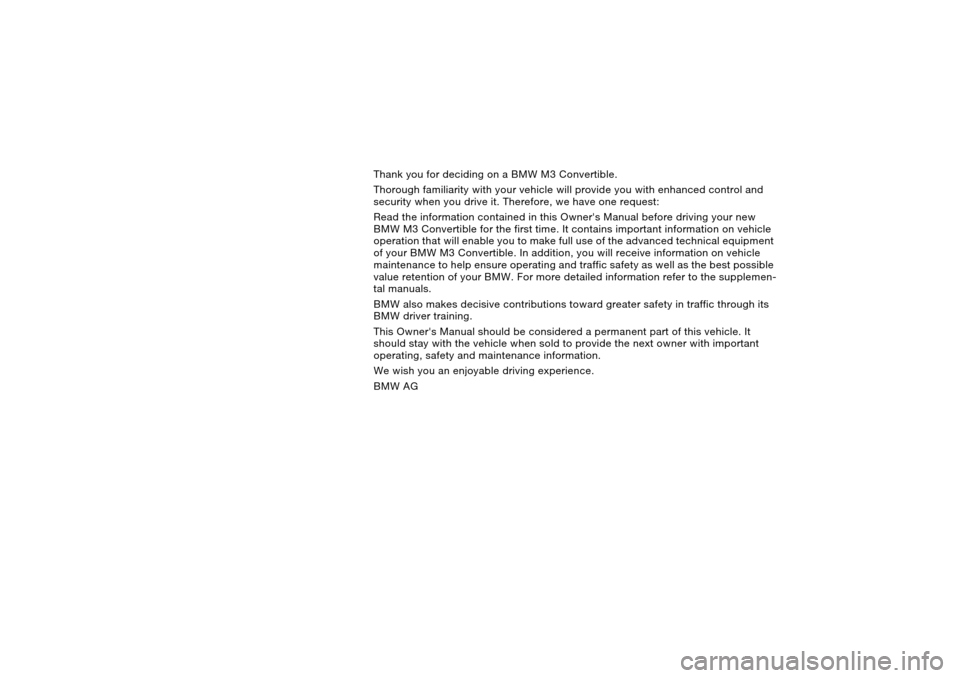
Thank you for deciding on a BMW M3 Convertible.
Thorough familiarity with your vehicle will provide you with enhanced control and
security when you drive it. Therefore, we have one request:
Read the information contained in this Owner's Manual before driving your new
BMW M3 Convertible for the first time. It contains important information on vehicle
operation that will enable you to make full use of the advanced technical equipment
of your BMW M3 Convertible. In addition, you will receive information on vehicle
maintenance to help ensure operating and traffic safety as well as the best possible
value retention of your BMW. For more detailed information refer to the supplemen-
tal manuals.
BMW also makes decisive contributions toward greater safety in traffic through its
BMW driver training.
This Owner's Manual should be considered a permanent part of this vehicle. It
should stay with the vehicle when sold to provide the next owner with important
operating, safety and maintenance information.
We wish you an enjoyable driving experience.
BMW AG
Page 29 of 174
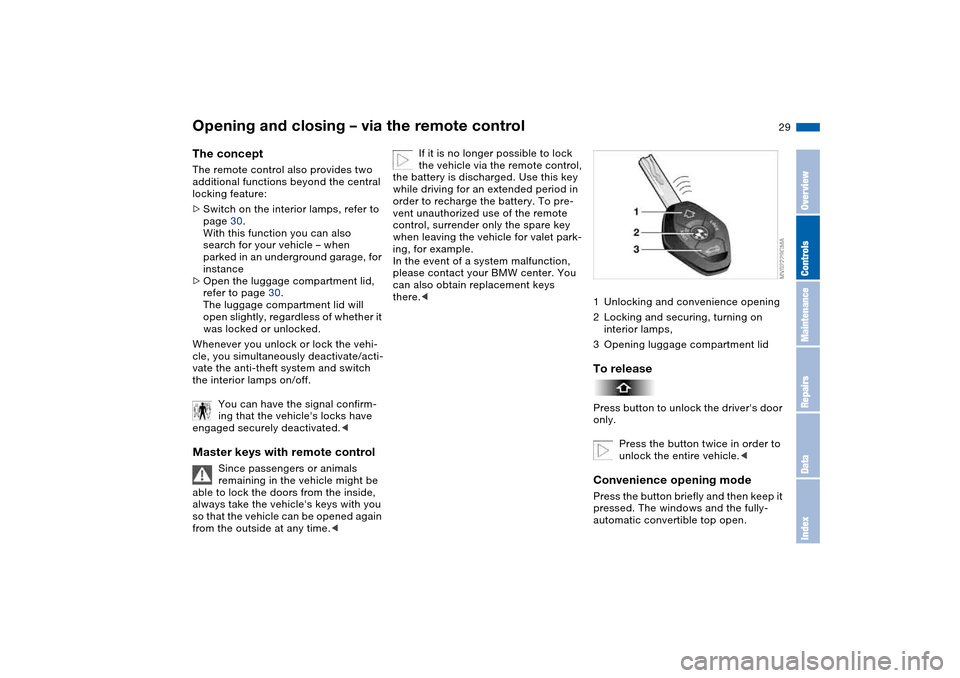
29
Opening and closing – via the remote controlThe conceptThe remote control also provides two
additional functions beyond the central
locking feature:
>Switch on the interior lamps, refer to
page 30.
With this function you can also
search for your vehicle – when
parked in an underground garage, for
instance
>Open the luggage compartment lid,
refer to page 30.
The luggage compartment lid will
open slightly, regardless of whether it
was locked or unlocked.
Whenever you unlock or lock the vehi-
cle, you simultaneously deactivate/acti-
vate the anti-theft system and switch
the interior lamps on/off.
You can have the signal confirm-
ing that the vehicle's locks have
engaged securely deactivated.
remaining in the vehicle might be
able to lock the doors from the inside,
always take the vehicle's keys with you
so that the vehicle can be opened again
from the outside at any time.<
If it is no longer possible to lock
the vehicle via the remote control,
the battery is discharged. Use this key
while driving for an extended period in
order to recharge the battery. To pre-
vent unauthorized use of the remote
control, surrender only the spare key
when leaving the vehicle for valet park-
ing, for example.
In the event of a system malfunction,
please contact your BMW center. You
can also obtain replacement keys
there.<
1Unlocking and convenience opening
2Locking and securing, turning on
interior lamps,
3Opening luggage compartment lidTo releasePress button to unlock the driver's door
only.
Press the button twice in order to
unlock the entire vehicle.
automatic convertible top open.
OverviewControlsMaintenanceRepairsDataIndex
Page 30 of 174
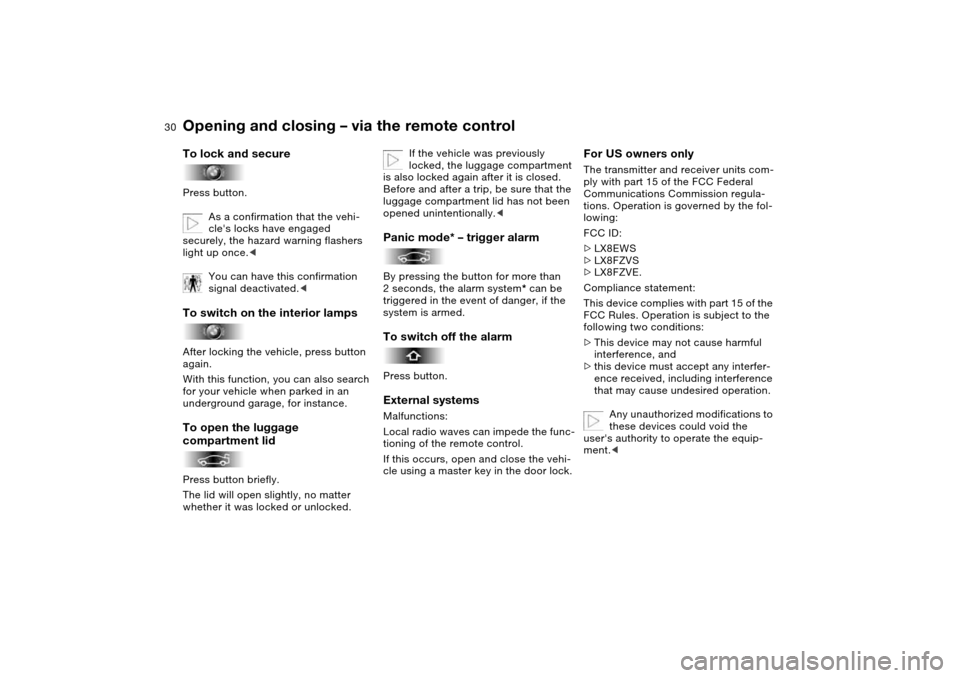
30
To lock and securePress button.
As a confirmation that the vehi-
cle's locks have engaged
securely, the hazard warning flashers
light up once.<
You can have this confirmation
signal deactivated.
With this function, you can also search
for your vehicle when parked in an
underground garage, for instance.To open the luggage
compartment lidPress button briefly.
The lid will open slightly, no matter
whether it was locked or unlocked.
If the vehicle was previously
locked, the luggage compartment
is also locked again after it is closed.
Before and after a trip, be sure that the
luggage compartment lid has not been
opened unintentionally.<
Panic mode* – trigger alarmBy pressing the button for more than
2 seconds, the alarm system* can be
triggered in the event of danger, if the
system is armed.To switch off the alarmPress button.External systemsMalfunctions:
Local radio waves can impede the func-
tioning of the remote control.
If this occurs, open and close the vehi-
cle using a master key in the door lock.
For US owners onlyThe transmitter and receiver units com-
ply with part 15 of the FCC Federal
Communications Commission regula-
tions. Operation is governed by the fol-
lowing:
FCC ID:
>LX8EWS
>LX8FZVS
>LX8FZVE.
Compliance statement:
This device complies with part 15 of the
FCC Rules. Operation is subject to the
following two conditions:
>This device may not cause harmful
interference, and
>this device must accept any interfer-
ence received, including interference
that may cause undesired operation.
Any unauthorized modifications to
these devices could void the
user's authority to operate the equip-
ment.<
Opening and closing – via the remote control
Page 31 of 174
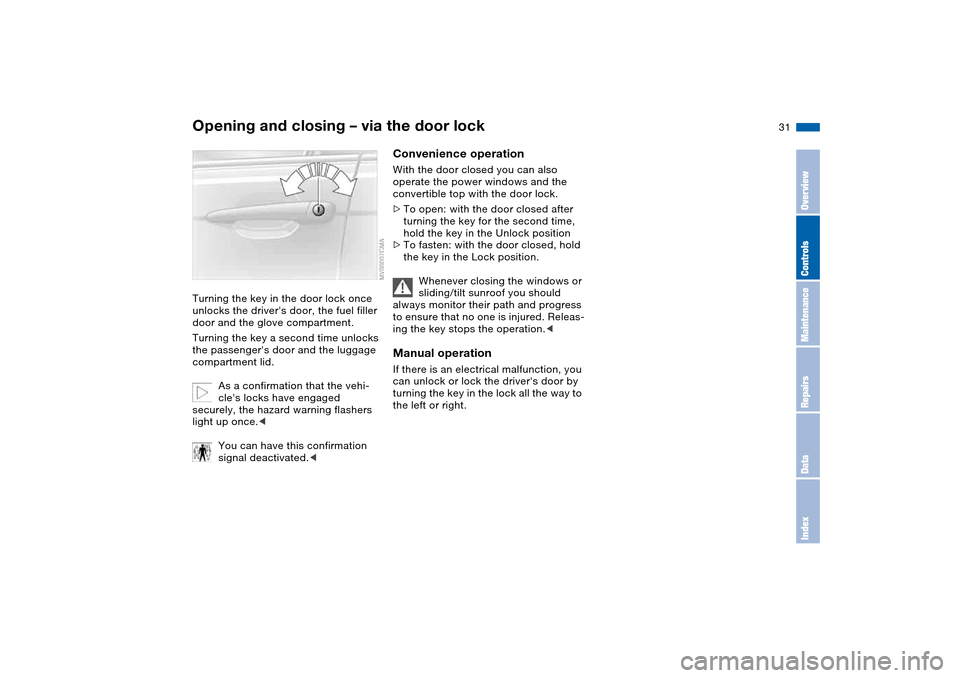
31
Opening and closing – via the door lockTurning the key in the door lock once
unlocks the driver's door, the fuel filler
door and the glove compartment.
Turning the key a second time unlocks
the passenger's door and the luggage
compartment lid.
As a confirmation that the vehi-
cle's locks have engaged
securely, the hazard warning flashers
light up once.<
You can have this confirmation
signal deactivated.<
Convenience operationWith the door closed you can also
operate the power windows and the
convertible top with the door lock.
>To open: with the door closed after
turning the key for the second time,
hold the key in the Unlock position
>To fasten: with the door closed, hold
the key in the Lock position.
Whenever closing the windows or
sliding/tilt sunroof you should
always monitor their path and progress
to ensure that no one is injured. Releas-
ing the key stops the operation.
turning the key in the lock all the way to
the left or right.
OverviewControlsMaintenanceRepairsDataIndex
Page 33 of 174
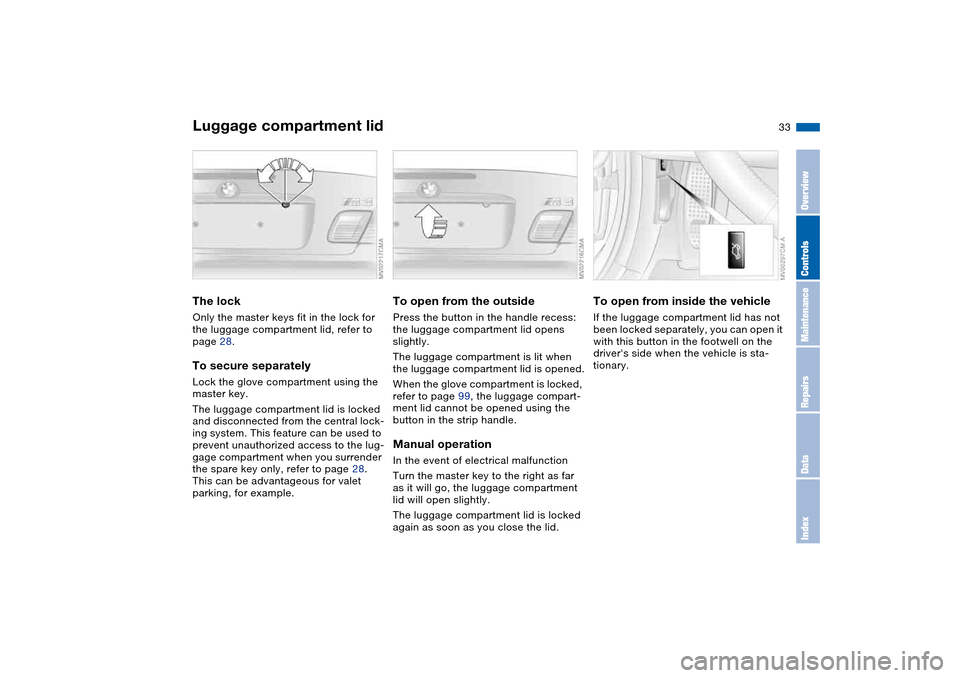
33
Luggage compartment lidThe lockOnly the master keys fit in the lock for
the luggage compartment lid, refer to
page 28.To secure separatelyLock the glove compartment using the
master key.
The luggage compartment lid is locked
and disconnected from the central lock-
ing system. This feature can be used to
prevent unauthorized access to the lug-
gage compartment when you surrender
the spare key only, refer to page 28.
This can be advantageous for valet
parking, for example.
To open from the outsidePress the button in the handle recess:
the luggage compartment lid opens
slightly.
The luggage compartment is lit when
the luggage compartment lid is opened.
When the glove compartment is locked,
refer to page 99, the luggage compart-
ment lid cannot be opened using the
button in the strip handle.Manual operationIn the event of electrical malfunction
Turn the master key to the right as far
as it will go, the luggage compartment
lid will open slightly.
The luggage compartment lid is locked
again as soon as you close the lid.
To open from inside the vehicleIf the luggage compartment lid has not
been locked separately, you can open it
with this button in the footwell on the
driver's side when the vehicle is sta-
tionary.
OverviewControlsMaintenanceRepairsDataIndex
Page 35 of 174
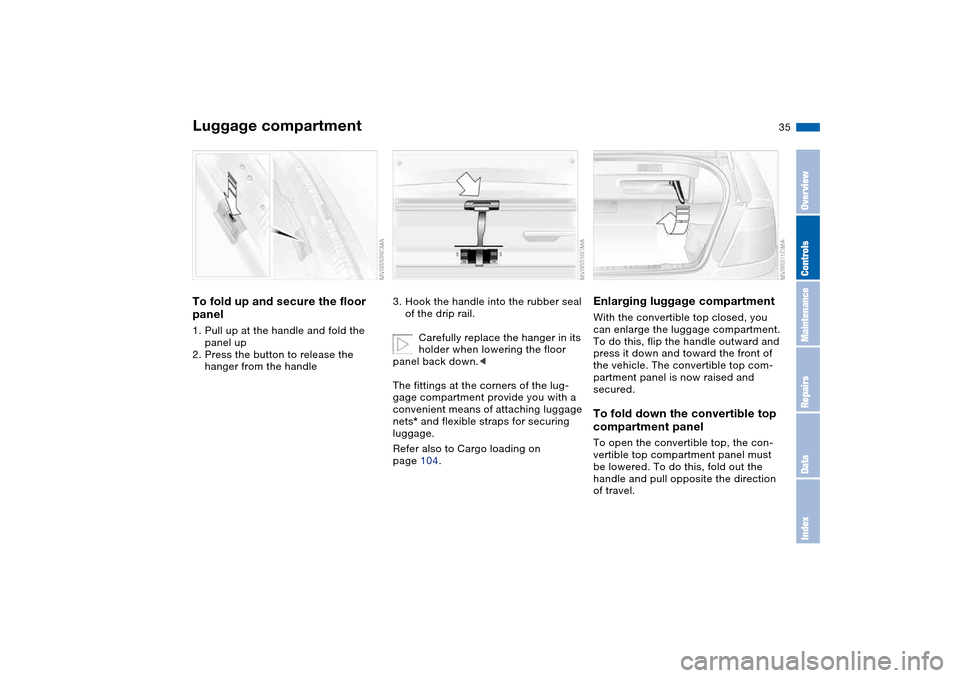
35
Luggage compartmentTo fold up and secure the floor
panel1. Pull up at the handle and fold the
panel up
2. Press the button to release the
hanger from the handle
3. Hook the handle into the rubber seal
of the drip rail.
Carefully replace the hanger in its
holder when lowering the floor
panel back down.<
The fittings at the corners of the lug-
gage compartment provide you with a
convenient means of attaching luggage
nets* and flexible straps for securing
luggage.
Refer also to Cargo loading on
page 104.
Enlarging luggage compartmentWith the convertible top closed, you
can enlarge the luggage compartment.
To do this, flip the handle outward and
press it down and toward the front of
the vehicle. The convertible top com-
partment panel is now raised and
secured.To fold down the convertible top
compartment panelTo open the convertible top, the con-
vertible top compartment panel must
be lowered. To do this, fold out the
handle and pull opposite the direction
of travel.
OverviewControlsMaintenanceRepairsDataIndex
Page 36 of 174
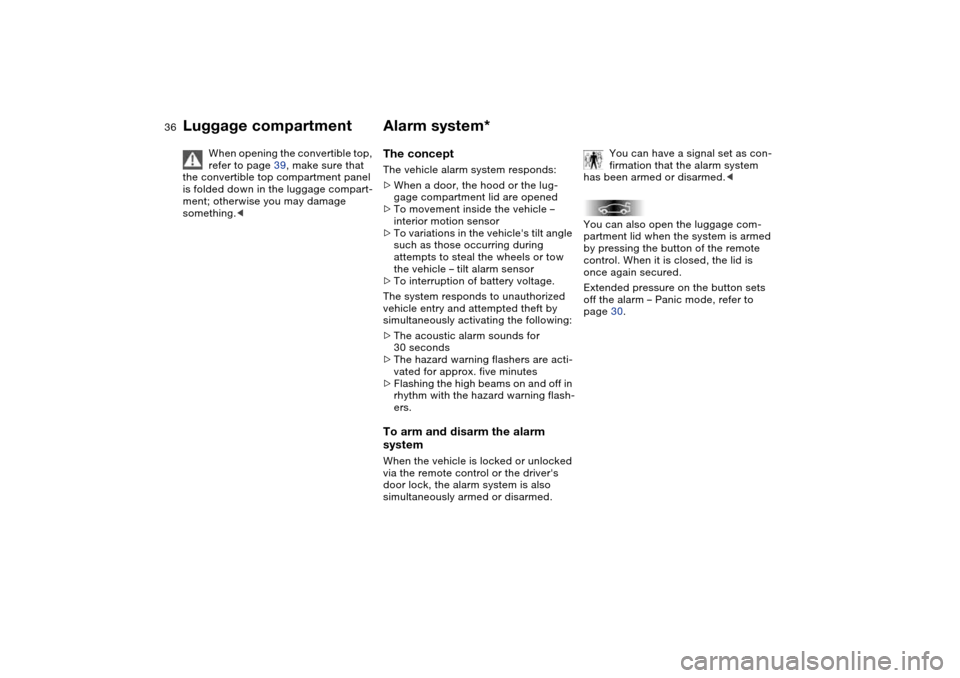
36
When opening the convertible top,
refer to page 39, make sure that
the convertible top compartment panel
is folded down in the luggage compart-
ment; otherwise you may damage
something.<
Alarm system*The conceptThe vehicle alarm system responds:
>When a door, the hood or the lug-
gage compartment lid are opened
>To movement inside the vehicle –
interior motion sensor
>To variations in the vehicle's tilt angle
such as those occurring during
attempts to steal the wheels or tow
the vehicle – tilt alarm sensor
>To interruption of battery voltage.
The system responds to unauthorized
vehicle entry and attempted theft by
simultaneously activating the following:
>The acoustic alarm sounds for
30 seconds
>The hazard warning flashers are acti-
vated for approx. five minutes
>Flashing the high beams on and off in
rhythm with the hazard warning flash-
ers.To arm and disarm the alarm
systemWhen the vehicle is locked or unlocked
via the remote control or the driver's
door lock, the alarm system is also
simultaneously armed or disarmed.You can have a signal set as con-
firmation that the alarm system
has been armed or disarmed.<
You can also open the luggage com-
partment lid when the system is armed
by pressing the button of the remote
control. When it is closed, the lid is
once again secured.
Extended pressure on the button sets
off the alarm – Panic mode, refer to
page 30.
Luggage compartment
Page 37 of 174
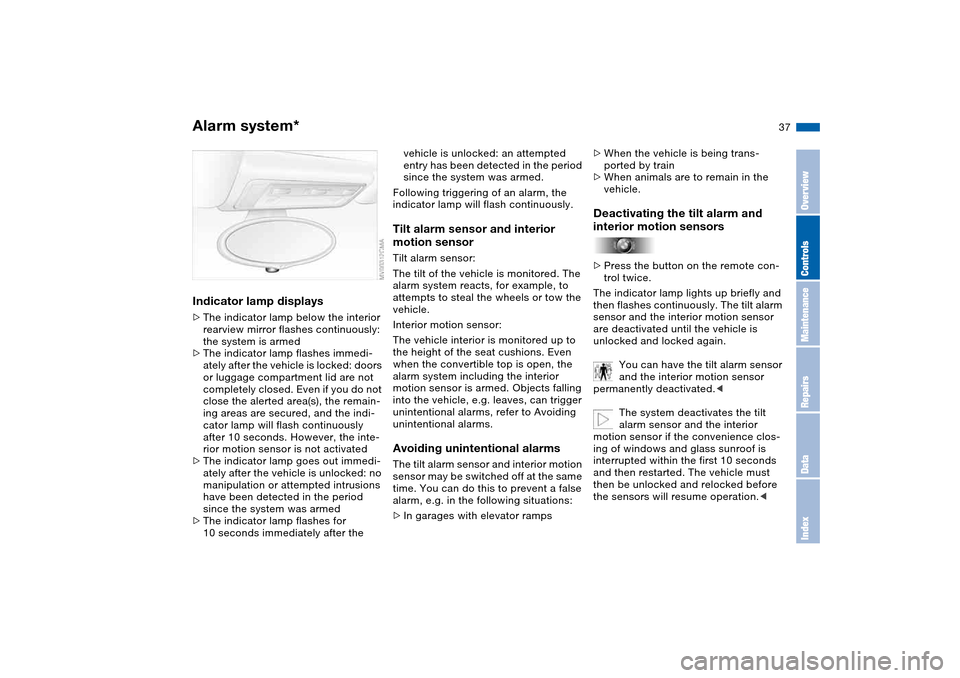
37
Indicator lamp displays>The indicator lamp below the interior
rearview mirror flashes continuously:
the system is armed
>The indicator lamp flashes immedi-
ately after the vehicle is locked: doors
or luggage compartment lid are not
completely closed. Even if you do not
close the alerted area(s), the remain-
ing areas are secured, and the indi-
cator lamp will flash continuously
after 10 seconds. However, the inte-
rior motion sensor is not activated
>The indicator lamp goes out immedi-
ately after the vehicle is unlocked: no
manipulation or attempted intrusions
have been detected in the period
since the system was armed
>The indicator lamp flashes for
10 seconds immediately after the
vehicle is unlocked: an attempted
entry has been detected in the period
since the system was armed.
Following triggering of an alarm, the
indicator lamp will flash continuously.Tilt alarm sensor and interior
motion sensorTilt alarm sensor:
The tilt of the vehicle is monitored. The
alarm system reacts, for example, to
attempts to steal the wheels or tow the
vehicle.
Interior motion sensor:
The vehicle interior is monitored up to
the height of the seat cushions. Even
when the convertible top is open, the
alarm system including the interior
motion sensor is armed. Objects falling
into the vehicle, e.g. leaves, can trigger
unintentional alarms, refer to Avoiding
unintentional alarms.Avoiding unintentional alarmsThe tilt alarm sensor and interior motion
sensor may be switched off at the same
time. You can do this to prevent a false
alarm, e.g. in the following situations:
>In garages with elevator ramps>When the vehicle is being trans-
ported by train
>When animals are to remain in the
vehicle.
Deactivating the tilt alarm and
interior motion sensors>Press the button on the remote con-
trol twice.
The indicator lamp lights up briefly and
then flashes continuously. The tilt alarm
sensor and the interior motion sensor
are deactivated until the vehicle is
unlocked and locked again.
You can have the tilt alarm sensor
and the interior motion sensor
permanently deactivated.<
The system deactivates the tilt
alarm sensor and the interior
motion sensor if the convenience clos-
ing of windows and glass sunroof is
interrupted within the first 10 seconds
and then restarted. The vehicle must
then be unlocked and relocked before
the sensors will resume operation.<
Alarm system*
OverviewControlsMaintenanceRepairsDataIndex
Page 58 of 174
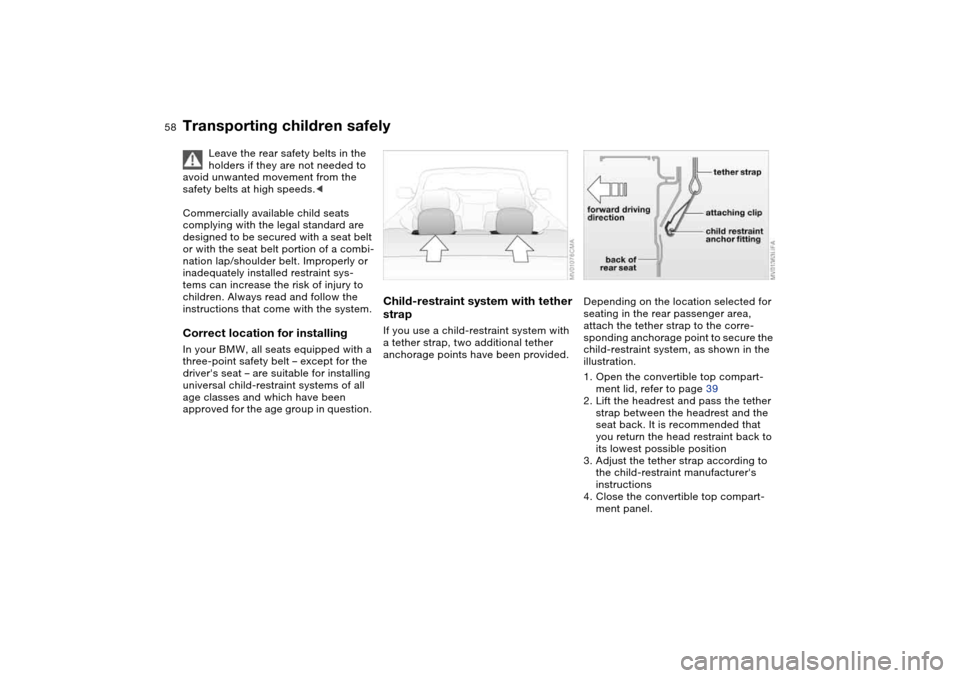
58
Transporting children safely
Leave the rear safety belts in the
holders if they are not needed to
avoid unwanted movement from the
safety belts at high speeds.<
Commercially available child seats
complying with the legal standard are
designed to be secured with a seat belt
or with the seat belt portion of a combi-
nation lap/shoulder belt. Improperly or
inadequately installed restraint sys-
tems can increase the risk of injury to
children. Always read and follow the
instructions that come with the system.
Correct location for installingIn your BMW, all seats equipped with a
three-point safety belt – except for the
driver's seat – are suitable for installing
universal child-restraint systems of all
age classes and which have been
approved for the age group in question.
Child-restraint system with tether
strapIf you use a child-restraint system with
a tether strap, two additional tether
anchorage points have been provided.
Depending on the location selected for
seating in the rear passenger area,
attach the tether strap to the corre-
sponding anchorage point to secure the
child-restraint system, as shown in the
illustration.
1. Open the convertible top compart-
ment lid, refer to page 39
2. Lift the headrest and pass the tether
strap between the headrest and the
seat back. It is recommended that
you return the head restraint back to
its lowest possible position
3. Adjust the tether strap according to
the child-restraint manufacturer's
instructions
4. Close the convertible top compart-
ment panel.
Page 59 of 174
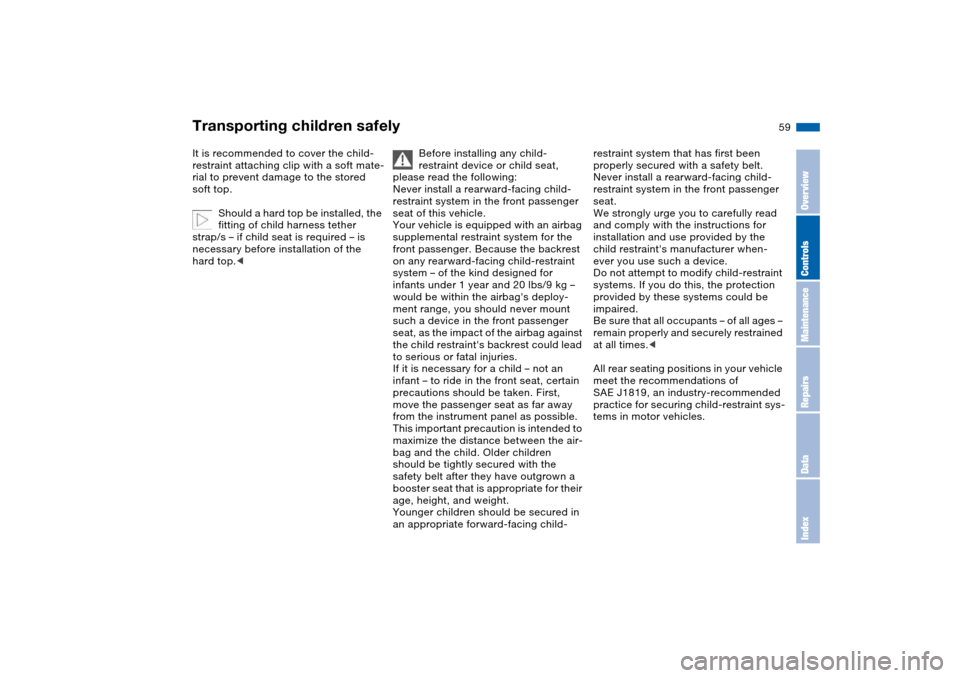
59
It is recommended to cover the child-
restraint attaching clip with a soft mate-
rial to prevent damage to the stored
soft top.
Should a hard top be installed, the
fitting of child harness tether
strap/s – if child seat is required – is
necessary before installation of the
hard top.<
Before installing any child-
restraint device or child seat,
please read the following:
Never install a rearward-facing child-
restraint system in the front passenger
seat of this vehicle.
Your vehicle is equipped with an airbag
supplemental restraint system for the
front passenger. Because the backrest
on any rearward-facing child-restraint
system – of the kind designed for
infants under 1 year and 20 lbs/9 kg –
would be within the airbag's deploy-
ment range, you should never mount
such a device in the front passenger
seat, as the impact of the airbag against
the child restraint's backrest could lead
to serious or fatal injuries.
If it is necessary for a child – not an
infant – to ride in the front seat, certain
precautions should be taken. First,
move the passenger seat as far away
from the instrument panel as possible.
This important precaution is intended to
maximize the distance between the air-
bag and the child. Older children
should be tightly secured with the
safety belt after they have outgrown a
booster seat that is appropriate for their
age, height, and weight.
Younger children should be secured in
an appropriate forward-facing child-
restraint system that has first been
properly secured with a safety belt.
Never install a rearward-facing child-
restraint system in the front passenger
seat.
We strongly urge you to carefully read
and comply with the instructions for
installation and use provided by the
child restraint's manufacturer when-
ever you use such a device.
Do not attempt to modify child-restraint
systems. If you do this, the protection
provided by these systems could be
impaired.
Be sure that all occupants – of all ages –
remain properly and securely restrained
at all times.<
All rear seating positions in your vehicle
meet the recommendations of
SAE J1819, an industry-recommended
practice for securing child-restraint sys-
tems in motor vehicles.
Transporting children safely
OverviewControlsMaintenanceRepairsDataIndex